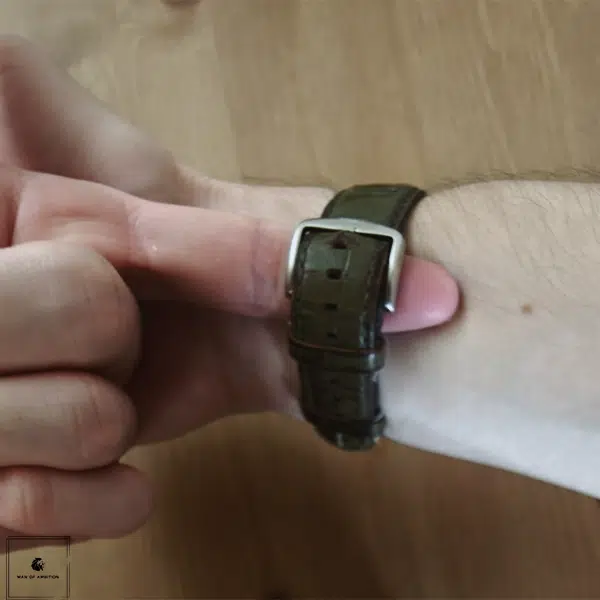What wrist do men wear watches on? Is it OK for a man to wear a watch on the right hand? These are common questions when it comes to wearing a watch, and while it may seem like a simple topic, there are a few things to consider. Let’s clear this up.
The short answer is: There is no set rule about which wrist to wear your watch on. However, most men wear their watch on their non-dominant hand. Since approximately 90% of people are right-handed[1], this means watches are typically worn on the left wrist. This makes sense from a practical standpoint, as it keeps the watch out of the way during daily tasks.

But what if you’re left-handed? Is there a specific rule for you? Well, as a lefty myself, I can assure you that there’s no strict etiquette here either. It’s all about comfort. The main goal is to wear your watch in a way that feels natural and doesn’t interfere with your daily activities.
Most people won’t even notice which wrist you wear your watch on—except maybe a quick “Oh, are you left-handed?”—and that’s it. The most common recommendation is to wear your watch on your non-dominant hand, but feel free to break this convention if it suits you better.
Table of Contents
Watch Design Basics and Daily Life Considerations
Watch Design
Most watches are designed with right-handed wearers in mind. This is why the crown (the knob used to adjust the time) is usually placed on the right side of the watch face, at the 3 o’clock position. This placement makes it easier for right-handed individuals to adjust the time with their right hand while the watch remains on their left wrist.
However, left-handed watches, with the crown positioned at 9 o’clock, are also available. This design allows lefties to wear their watch on their right wrist without difficulty when adjusting the time. That said, as a left-handed person who wears a regular watch on my right wrist, I can tell you it’s not a big deal to reach the crown on the opposite side.
Daily Life Tasks
Comfort should be your priority when deciding which wrist to wear your watch on. Think about your daily routine and how often you use your dominant hand. Right-handed people typically wear their watch on their left wrist to avoid interference while writing or performing other tasks. Similarly, left-handed people often choose the right wrist for their watch for the same reason.
It’s also practical to consider protecting your watch. Wearing it on your non-dominant hand can help prevent accidental bumps and scratches, as it’s less likely to get in the way of daily activities. Since watches are often one of the few pieces of jewelry men wear, you want to keep yours in good condition. If there’s a task where your watch might be in danger (like heavy lifting or working with tools), it’s best to simply remove it for the duration of that activity.
Another reason many men prefer wearing their watch on their non-dominant hand is that it allows them to easily check the time while performing other tasks, without having to stop what they’re doing.
Which Wrist Should I Wear My Watch On?
At the end of the day, there are no strict rules about which wrist you should wear your watch on. The general guideline is to wear it on your non-dominant hand for comfort and practicality. However, the most important factor is what feels natural to you.
If you’re a lefty and prefer wearing your watch on the left wrist—go for it! If you’re right-handed but find it more comfortable to wear your watch on the right, that’s perfectly fine too. The key is to do what suits you best.
Common questions (FAQ)
How should I position my watch on my wrist?
As a general rule, you should wear your watch on the thinnest part of your wrist. This ensures it stays secure without sliding around. Some people prefer wearing it directly on the wrist bone, but I find that uncomfortable. Experiment with placement to find what feels right for you.
How tight should my watch be?
Your watch should be tight enough that it doesn’t slide around your wrist, but not so tight that it feels restrictive or uncomfortable. A good test is to ensure you can slide one finger between the strap and your wrist. This provides a comfortable fit without risking the watch falling off.

When it comes to wearing a watch, the most important factor is comfort. While most people wear their watch on their non-dominant hand, there’s no hard-and-fast rule. Consider your daily tasks, the design of your watch, and how it feels on your wrist. Ultimately, wear your watch in the way that suits you best.
For more tips on how to perfectly wear and style a watch, be sure to check out our Complete Guide to Wearing a Watch for Men.

